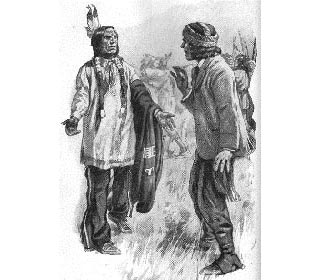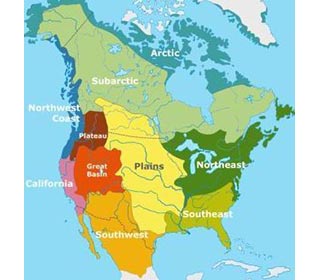What did the Pima tribe live in?
The Pima tribe (Akimel O'odham) lived along the Gila River, Salt River, Yaqui River, and Sonora River in ranchería style villages. The Spanish word rancherío, referred to a small, rural settlement and the term was applied to Native American Indian villages. The Pima houses were rectangular in shape and made from split planks of timber with a pitched roof and a smoke hole at the top. The houses were built over an in-ground pit lined with wood and stone which provided the floor and the lower half of the surrounding walls. Some Pima Native Indians were driven from their farms due to attacks from other tribes such as the Apache. These semi-nomadic Pima Indians adopted the temporary brush shelter homes called wickiups that were used for sleeping. A wickiup was a cone-shaped structure and made of a wooden frame covered with branches, leaves, and grass (brush). What language did the Pima tribe speak?
The Pima tribe spoke in a Uto-Aztecan language and call themselves the “River People”. What did the Pima tribe eat?
The food that the Pima tribe ate included meals made from the crops they cultivated including corn (maize), kidney beans, sunflower seeds, pumpkins and squash. Small game, such as rabbit was a staple part of their diet together with meat from their livestock such as sheep and goats. Larger game was also available such as deer, elk and bear. As they were in close proximity to rivers fish, duck and many different types of shellfish were major elements of their diet which was also supplemented with herbs, acorns and roots. The Pima women gathered wild plants such as cactus fruit and mesquite seeds. What weapons did the Pima use?
The weapons used by the Pima tribe were the bow and arrow, war clubs, spears and knives. They also made rawhide shields for defence. What clothes did the Pima men wear?
The clothes worn by the men included breechcloths or short kilts which were made from a long rectangular piece of animal skin or cloth which was worn between the legs and tucked over a belt. During the 1800's men started to wear cotton tunics over deer skin leggings. They wore sandals made of rawhide or yucca fiber rather than moccasins. Pima men often twisted their long hair into hair rolls, which they would wind up around their heads which they sometimes covered with a turban. What clothes did the Pima women wear?
The women of the Pima tribe wore cotton blouses and knee-length skirts with cloaks worn at night for protection from the elements. Pima women wore their hair long and straight with bangs in front. They also wore shell an turquoise jewelry and were especially fond of elaborate necklaces. What was the religion and beliefs of the Pima tribe?
The religion and beliefs of the Pima tribe was based on Animism that encompassed the spiritual or religious idea that the universe and all natural objects animals, plants, trees, rivers, mountains rocks etc have souls or spirits. The chief god of the Pima tribe was called "Earthmaker", and among the other spirits they revered, the most notable deity was known as Elder Brother. Who were the most famous leaders and chiefs of the Pima tribe?
The most famous leaders and chiefs of the Pima tribe included Chief Ursuth, Chief Antonio and Chief Antonito. Pima History: What happened to the Pima tribe?
The Pima tribe At first submitting to the Spaniards, they revolted in 1751, destroying all the missions. The war lasted two years, but since then the Pima Indians have been friendly with the settlers. As a race they are brave, honest and hard working. They number some 5000 on two reservations in Arizona. The Pima Tribe's first encounter with the whites was in 1589, when they were visited by the Spaniard, Father Marcos de Niza. In the 1600's the Spanish began to impose their rule on the Pima which included a form of taxation. In 1695 the southern Pima mounted a rebellion against the Spanish, but were quickly suppressed and many were made homeless and forced to adopt a semi-nomadic lifestyle. In 1697 the Pima tribe living along the Gila River, Arizona were visited by the Jesuit priest and explorer, Father Eusebio Kino (August 10, 1645 - March 15, 1711). Father Eusebio Kino helped the Pima Indians in modern farming methods, bringing them new types of seeds and farm animals. He also fought against the forced labor of Native American Indians in northern Mexican silver mines. Another large revolt was mounted against the Spanish in 1751 this was also suppressed. The United States acquired Pima territory in 1853 with the Gadsden Purchase, which saw an influx of white settlers and farmers encroaching their lands. Most of the Pima tribe living in the region were forced to move to the Salt River reservation. The Pima tribe now live, together with the Maricopa tribe, on the Gila River and Salt River reservations and, with the Tohono O'Odham (Desert People) tribe, on the Ak-Chin reservation, all which are located in Arizona. The Story of Pima
For additional facts and information refer to the Pima story Coyote Proud. | 
